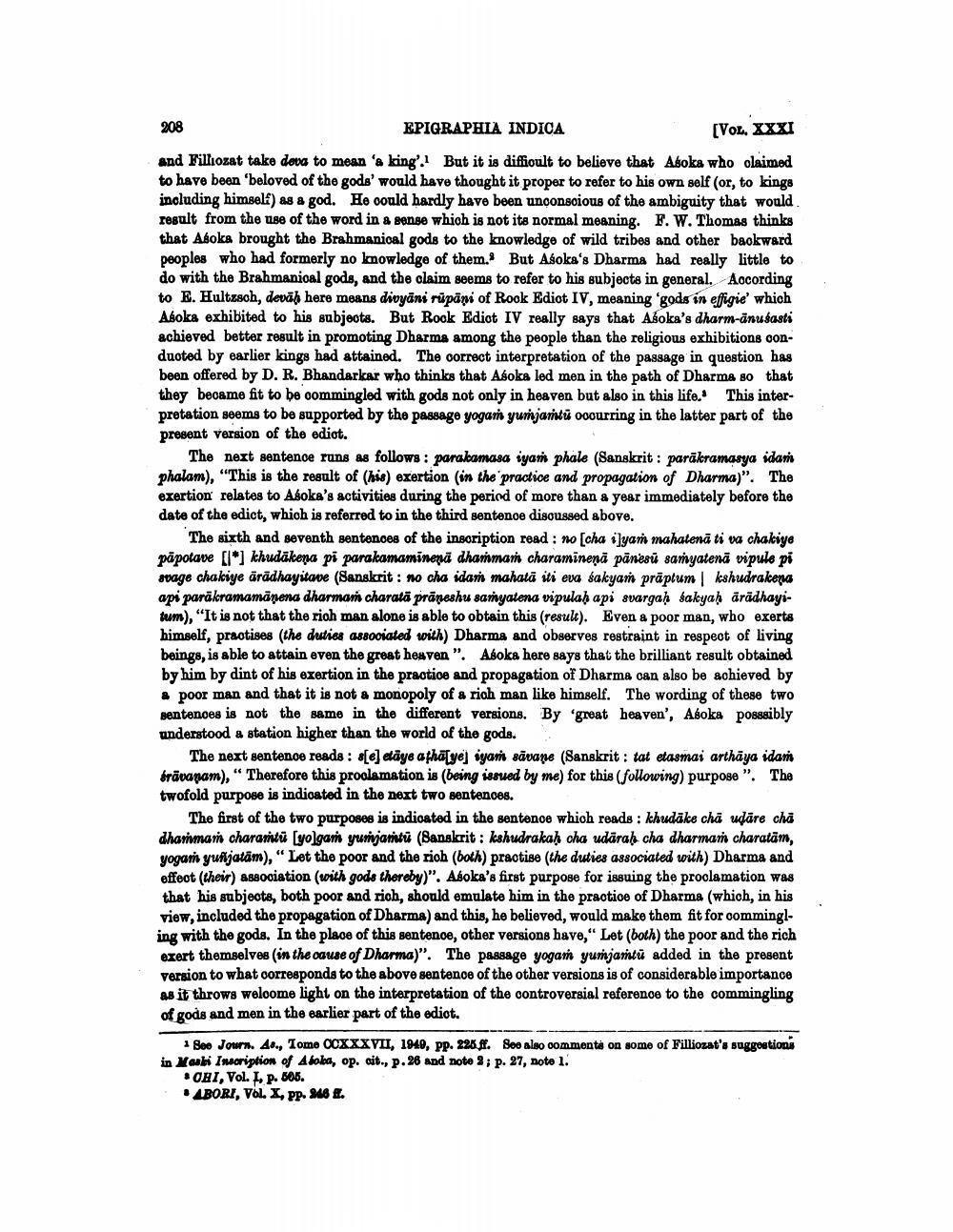________________
208 EPIGRAPHIA INDICA
(VOL. XXXI and Filliozat take dova to mean 'a king'. But it is diffioult to believe that Asoka who claimed to have been 'beloved of the gods' would have thought it proper to refer to his own self (or, to kings including himself as a god. He could hardly have been unconscious of the ambiguity that would result from the use of the word in a sense which is not its normal meaning. F. W. Thomas thinks that Aboks brought the Brahmanioal gods to the knowledge of wild tribes and other backward peoples who had formerly no knowledge of them. But Asoka's Dharma had really little to do with the Brahmanioal gods, and the claim seems to refer to his subjects in general. According to E. Hultzsch, devāh here means divyāni rūpāni of Rock Ediot IV, meaning 'gods in effigie' which Aboka exhibited to his subjeots. But Rook Ediot IV really says that Asoka's dharm-ānusasti achieved better result in promoting Dharma among the people than the religious exhibitions oonduoted by earlier kings had attained. The correct interpretation of the passage in question has been offered by D. R. Bhandarkar who thinks that Asoka led men in the path of Dharma so that they became fit to be commingled with gods not only in heaven but also in this life. This interpretation seems to be supported by the passage yogam yurjanti ooourring in the latter part of the present version of the edict.
The next sentence runs as follows: paralamasa iyan phale (Sanskrit: parākramasya idan phalam), "This is the result of (his) exertion in the practice and propagation of Dharma)". The exertion relates to Asoka's activities during the period of more than a year immediately before the date of the edict, which is referred to in the third sentence disoussed above.
The sixth and seventh sentences of the inscription read: no [cha ilyar mahatenā ti va chakiye päpotave [l*] khudākena pi parakamaminenă dhammam charaminenā pānesú samyatenā vipule pi svage chakiye ārādhayitave (Sanskrit : no cha idam mahatā iti eva sakyam präptum kshudrakera api parakramamāpena dharmań charatā prāneshu sanyatena vipulah api svargah sakyah ärādhayitum), "It is not that the rich man alone is able to obtain this (result). Even a poor man, who exerts himself. praotises (the duties associated with) Dharma and observes restraint in respect of living beings, is able to attain even the great heaven". Asoka here says that the brilliant result obtained by him by dint of his exertion in the practioe and propagation of Dharma can also be achieved by & poor man and that it is not a monopoly of a rich man like himself. The wording of these two sentences is not the same in the different versions. By 'great heaven', Asoka posssibly understood a station higher than the world of the gods.
The next sentence reads : s[e] etaye atha[ye) iyam sāvane (Sanskrit: tat etasmai arthāya idam brāvanam)," Therefore this proolamation is being issued by me) for this following) purpose". The twofold purpose is indicated in the next two sentences.
The first of the two purposes is indicated in the sentence which reads : khudāke cha udāre cha dharma charamtü (yolgar yurijantů (Sanskrit: kshudrakah cha udārah cha dharmań charatām, vooań yufsjatām), “Let the poor and the rich (both) practise (the duties associated with) Dharma and effeot (their) association (with gods thereby)". Asoka's first purpose for issuing the proclamation was that his subjects, both poor and rich, should emulate him in the practice of Dharma (which, in his view, included the propagation of Dharma) and this, he believed, would make them fit for commingling with the gods. In the place of this sentence, other versions have," Let (both) the poor and the rich exert themselves in the cause of Dharma)". The passage yogam yumjantu added in the present version to what corresponds to the above sentence of the other versions is of considerable importance as it throws weloome light on the interpretation of the controversial reference to the commingling of gods and men in the earlier part of the ediot.
Seo Journ. As., Tomo OCXXXVII, 1940, PP. 226ff. Soo also comments on some of Filliozat's suggestions in Maski Inscription of Aboba, op. cit., p. 26 and note 3; p. 27, noto 1.
• OHI, Vol. I. p. 606.
ABORI, VOL. X, PP. 26 f.




